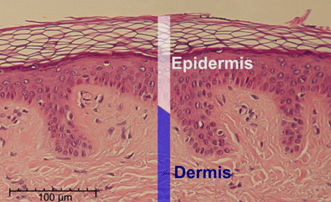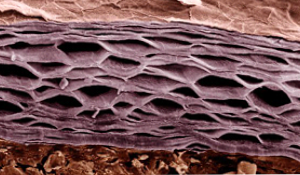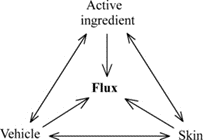Transdermal drug administration is gaining an important place in modern drug therapy. The global transdermal market was at $5.8B (USD) in 2018 and is expected to generate over $8.0B (USD) by 2025. Transdermal patches accounted for the largest share in the global market in 2018, due to their benefits like decreased dosing frequency, enhanced bioavailability, and ability of drug termination at any stage by simply removing the patch. Success in this market relies on the ability to of products to efficiently penetrate the tough multi-layered barrier of the outer skin - the stratum corneum.

The stratum corneum is a matrix of extra-cellular lipids and dying skin cell components that are making their way to the surface to be sloughed off. This arrangement of mostly keratinocytes combined with the lipid rich extracellular space forms a ‘brick and mortar’ model that creates a thin but tough layer of the epidermis. This dead layer of tissue prevents the permeation of foreign compounds, including drug molecules, and therefore acts as a very effective protective barrier.
There are two possible routes through the stratum corneum.
Trans-epidermal penetration can be termed intra- or inter-cellular.
- The intra-cellular route through corneocytes and keratinocytes, allows the transport of hydrophilic or polar solutes.
- Transport via inter-cellular spaces allows diffusion of lipophilic or non-polar solutes through the continuous lipid matrix.
Trans-appendageal penetration involves the passage of molecules through sweat glands and across the hair follicles.
Even the most ideal molecules have difficulty penetrating the stratum corneum.
The development of the optimized ‘vehicle’ needs to be considered on a case by case basis. The formulator also must consider not only how the skin resistance changes as the active ingredient is applied, but also how the vehicle reacts during application. Does the vehicle soften the skin and loosen the matrix for penetration? Is the vehicle volatile (e.g. water, propylene glycol) and will change after application to the skin?2
Beyond the vehicle – there are some general guidelines that formulators use to improve flux:
- Thermodynamics – is there a driving force - natural or applied - beyond concentration gradient that improves permeation into the skin?
- Supersaturation – is there more than enough molecule to create a favorable penetration?
- Permeation modifier - as we have discussed in other posts – there are ways to make a transdermal patch or an active ingredient more likely to penetrate the skin barrier.
Crafty formulators and development companies are always looking for ways to improve flux. Some specialize with permeation modifiers while others look at thermodynamic and energy potential. Forward thinkers are looking at ways to combine these drivers while others are looking at ‘reverse permeation’ to develop predictive and diagnostic tools. The future of transdermal delivery relies on cost effective, easy to use, and safe delivery methods that improve patient compliance and lead to better outcomes. From the looks of it – we are just beginning to scratch the surface.


